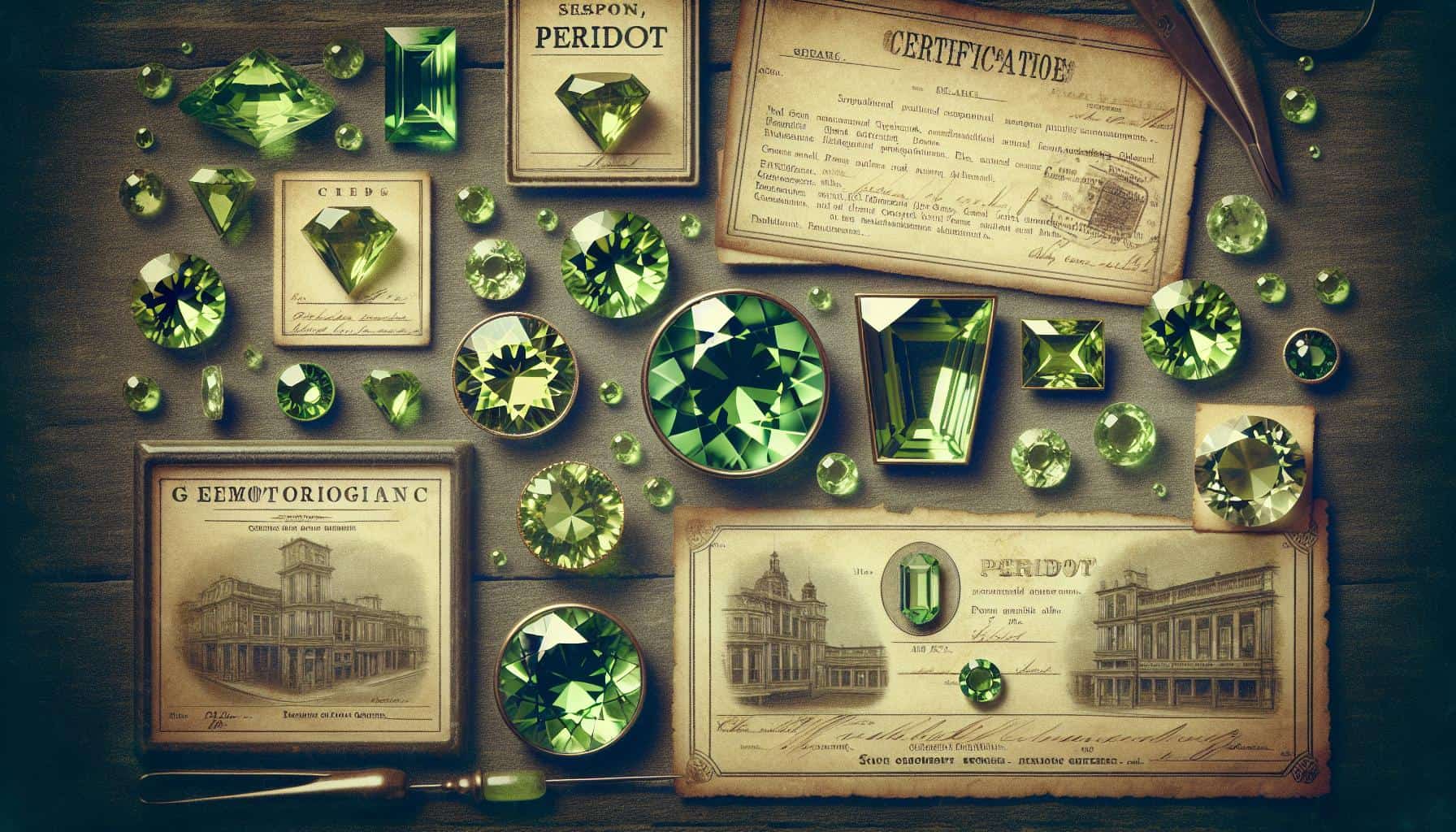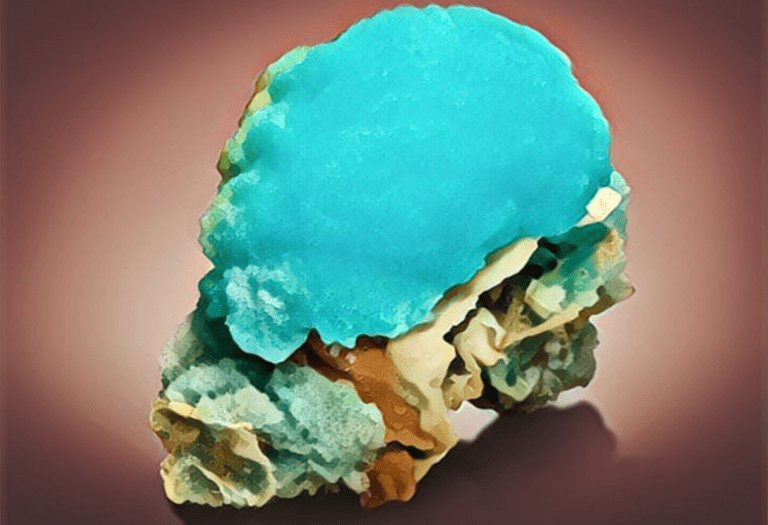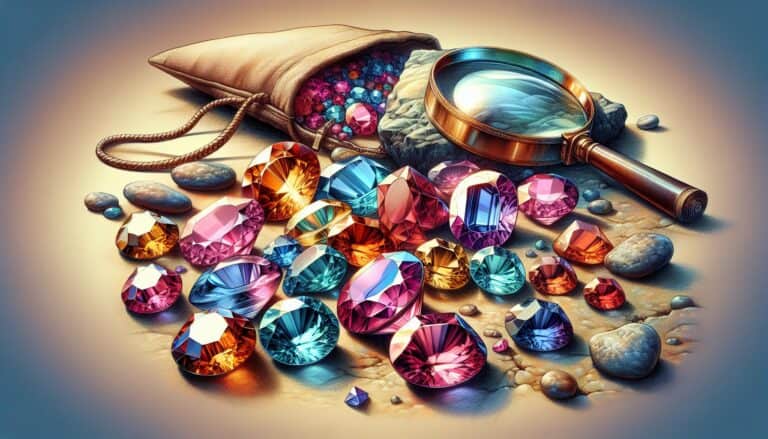Ever wondered about the value of that sparkling peridot jewelry you’ve eyed?
Peridot, with its unique olive-green hue, is more than just a gemstone; it’s a statement of class and timelessness. But before you dive into your wallet, it’s crucial to understand what factors into its worth.
From its vibrant color to its size and clarity, the worth of peridot can vary widely. You’re about to discover the intricacies that determine its value and why this gem might be the perfect addition to your collection.
Whether you’re a seasoned collector or a curious newbie, knowing peridot’s worth is key to making informed decisions.
Peridot value is influenced by color, clarity, cut, and size. The most desirable shade is a deep olive green. Larger, eye-clean stones with vibrant color and expert cuts are more valuable. Prices vary with rarity and source location, particularly for high-quality stones from the Pakistani Himalayas.
What Is Peridot?
Peridot, a gem-quality variety of the mineral olivine, is one of the few gemstones that come in a single color: a distinctive signature lime green. The intensity and tint of the green depend on the proportion of iron present in the crystal structure, which results in shades ranging from yellowish-green to olive to brownish-green. This unique green hue is most vibrant under natural daylight or fluorescent lighting.
Though peridot is widely recognized for its color, it also has a rich history. Often referred to as the evening emerald because it doesn’t lose its sparkle under artificial light, peridot has been cherished for over 4,000 years and was historically believed to ward off evil spirits. It’s also known for being the birthstone for the month of August and is said to bring good fortune and peace to its wearer.
When assessing peridot, it’s pivotal to consider its source. Peridot is found in various parts of the world, including the United States (Arizona), China, Myanmar, and Pakistan. The finest quality of peridots are sourced from the Pakistani mines of the Himalayas, where the stones boast the most coveted deep olive hues.
With Mohs hardness ranging from 6.5 to 7, peridot is suitable for a variety of jewelry pieces, including rings, necklaces, and bracelets. However, due to its relative softness compared to other gems, it requires careful handling to avoid scratches and damage.
Attention to care and cleaning is essential for maintaining the luster and appearance of peridot jewelry. Softer than many precious stones, peridots should be cleaned using a soft brush and mild soap; abrasive materials or harsh chemicals can damage the stone. It’s also advised to store your peridot jewelry in a separate compartment to avoid contact with harder gemstones that could potentially scratch it.
Understanding the characteristics of peridot is paramount when considering its value. Your appreciation for this vibrant gem will grow as you learn more about its unique attributes and the factors that influence its worth.
Peridot Prices: Factors That Affect Value
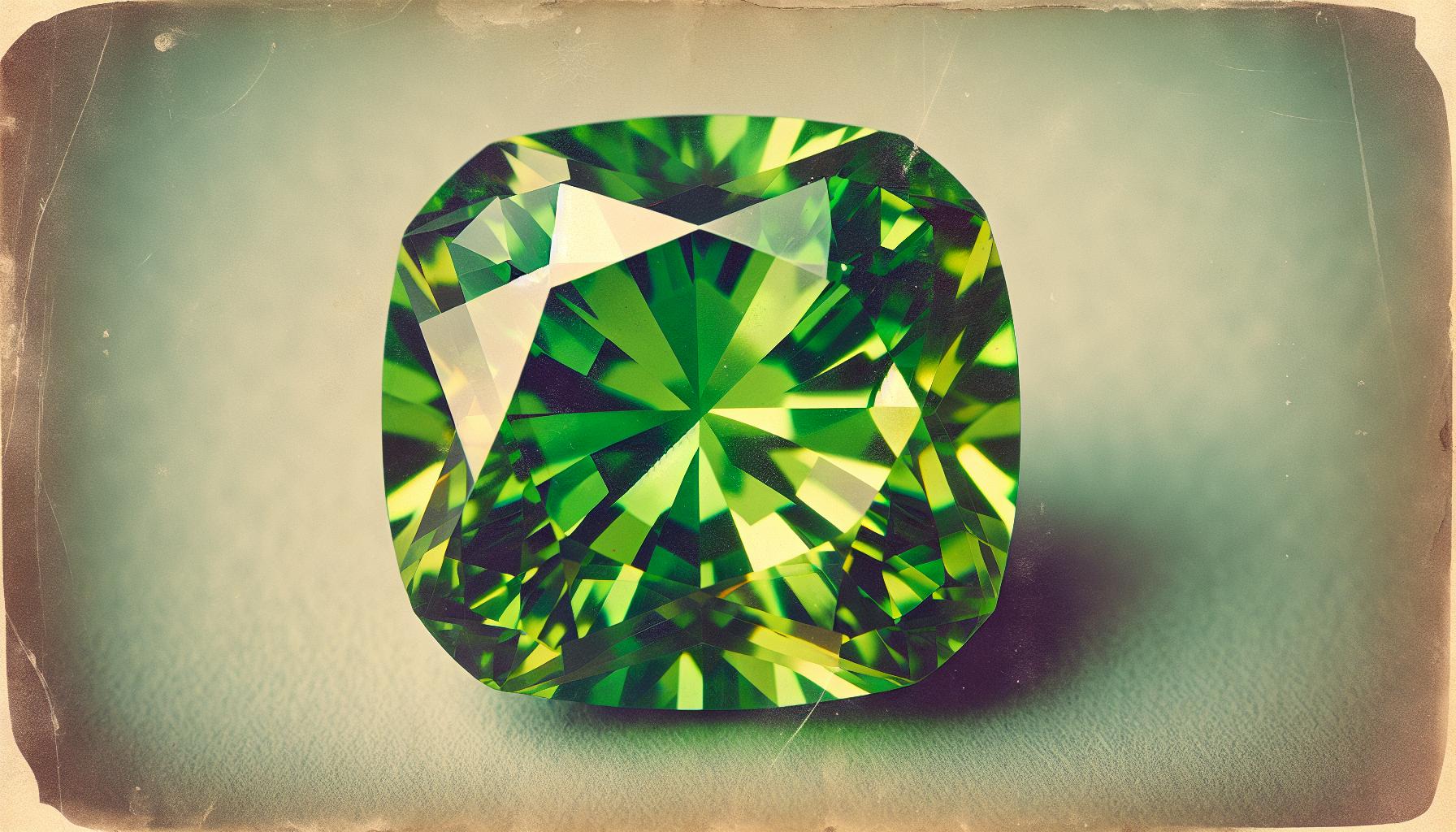
When you dive into the world of peridot, understanding what affects its price ensures you make informed purchasing decisions. Let’s dissect the key elements contributing to the value of peridot stones.
Color, Clarity, and Cut Quality
Color is paramount in determining peridot’s worth. You’re looking for a vibrant, rich green hue, which signifies a higher quality gem. The preferable shade is a deep, lush green with a slight golden tinge. Pure grass green peridots often fetch higher prices in the market.
Clarity impacts value as well. Most peridot gems have few inclusions, which are often difficult to spot with the naked eye. However, stones that boast exceptional transparency and minimal spots, feathers, or cloudiness are generally more valuable. Eye-clean peridots, meaning those without visible flaws, are the most sought after.
The cut quality significantly influences a peridot’s sparkle and overall appearance. A well-cut peridot will exhibit even color, display the fewest inclusions, and showcase the gem’s inherent beauty. Artful cutting can bring out the best in even modest stones. So, if you’re examining a peridot, pay attention to symmetrical cuts and proper proportions, which enhance the stone’s natural allure.
Market Demand and Availability
Understanding market dynamics is essential when evaluating peridot prices. Demand for peridot can fluctuate with fashion trends and consumer preferences. When there’s a surge in demand, prices might increase; however, if the stone falls out of favor, prices could diminish.
Availability also plays a crucial role. Peridot is considered a relatively abundant gemstone, but the market value can rise significantly for stones with particular characteristics. The source can matter tremendously. For instance, peridots from the Pakistani mines of the Himalayas are often more valuable due to their superior color and size.
Remember that larger peridots are rarer and thus more expensive. Stones above ten carats are exceptional finds and carry a premium. On the other hand, smaller stones, below five carats, are more common and accessible, resulting in more modest prices.
As you explore the peridot market, keep in mind that each stone is unique. Its value is tied to a combination of factors. Rarity, color, clarity, cut – they all intertwine to dictate the final price tag of a peridot. Thoroughly inspect stones for those critical characteristics and stay up-to-date with market fluctuations to gauge the true worth of peridot jewelry.
Understanding Peridot: A Rare Gem
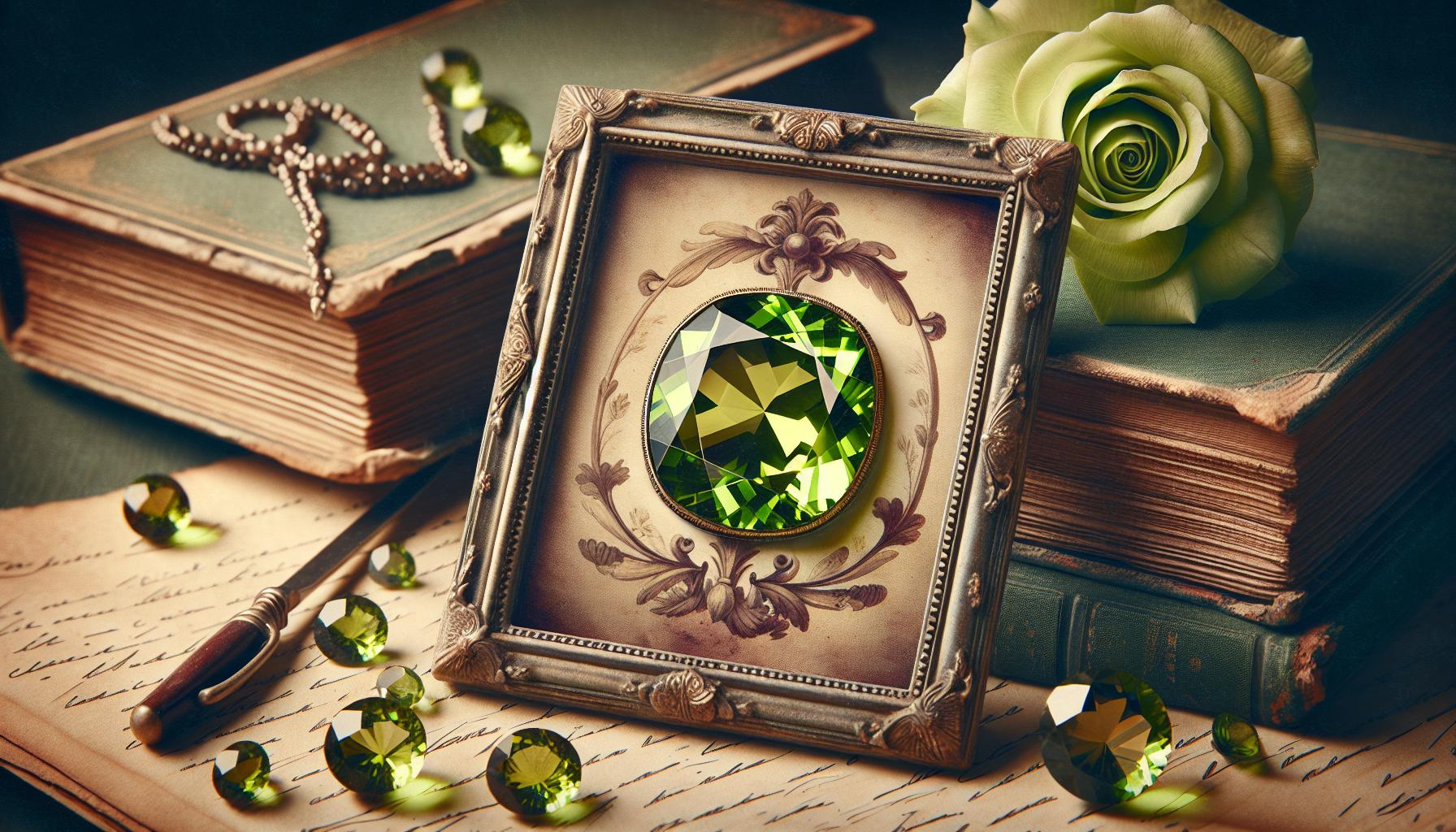
The Rarity of Peridot
Peridot, a gem often noted for its distinctive green hue, stands apart due to its rarity. Unlike many gems that are found in various locations around the world, peridot is sourced from a limited number of places, which adds to its uniqueness and allure. Among these, the island of Zabargad in Egypt is historically famous as a source of high-quality peridot since ancient times. However, Arizona, China, Myanmar, Pakistan, and Vietnam are among the few modern producers of this gemstone, with each location offering stones with different characteristics.
It’s pertinent to realize that the size of peridot significantly influences its rarity. Peridot stones above 10 carats are considerably scarce, and as the carat weight increases, the rarity and consequently the value, shoots up. This scale of rarity isn’t uniform and can be impacted by extraordinary discoveries which may momentarily increase availability.
Origins and Characteristics
Peridot, often mistaken for emerald in antiquity, is born out of the earth’s fiery depths. Interestingly, it is one of the few gemstones that occur in only one color: green. However, the intensity and hue can range from a pale yellow-green to a rich olive tone, depending on the amount of iron content present in the crystal structure. This makes each stone’s color subtly unique.
Geologically speaking, peridot is found in Igneous Rocks and sometimes even in Meteorites, though the space-born peridot is not suitable for use in jewelry. Your understanding of this gem’s origins should include its volcanic birthright. Most peridot gems form deep within the Earth and are brought to the surface through volcanic activity. Because of its link to earth’s upheavals, each piece of peridot carries a distinct geological history, marking it with characteristics that contribute to its overall allure and value.
The allure of peridot is further accentuated by its double refraction quality. When looking through the gem, you’ll see two of each pavilion facet, an effect that heightens the stone’s vibrancy and sparkle. This distinctive feature contributes to its growing popularity among gem collectors and jewelers who appreciate peridot’s lustrous and unique visual appeal.
In terms of hardness, peridot sits at 6.5 to 7 on the Mohs Scale, making it softer than many other gemstones. While durable enough for jewelry, it warrants careful handling to avoid scratches and maintain its brilliance. With proper care, peridot jewelry retains its beauty for generations, symbolizing the timeless nature of this rare gem.
Your journey through the green depths of peridot’s value is intricate, as every characteristic interweaves with its backstory to set the stage for its worth in the current market.
Peridot Grading and Valuation
The Grading System for Peridot
When you’re looking to assess the value of peridot, understanding the grading system can be incredibly helpful. Much like diamonds, peridots are graded based on certain criteria, although there isn’t a universally standardized system. The primary factors that determine a peridot’s grade include color, clarity, cut, and carat weight—collectively known as the Four Cs.
Color is the most critical aspect when grading peridot, with the finest stones displaying a vibrant, grassy green without any hints of brown or yellow. Clarity follows, where peridots with fewer inclusions or blemishes fetch higher prices. The cut of the stone can also greatly affect its appearance and sparkle, with well-cut gems reflecting light more brilliantly. Lastly, the carat weight plays into the valuation, though it’s worth noting that peridot doesn’t increase in value exponentially with size due to its relatively abundant nature.
- Color: Look for a rich, green hue without brown or yellow overtones.
- Clarity: Expect fewer inclusions in higher quality stones.
- Cut: A fine cut will enhance the gem’s brilliance and overall look.
- Carat Weight: Larger stones are available, but value increases moderately with size.
Certification and Appraisal
If you’re serious about determining the worth of your peridot, obtaining a certification from a reputable gemological laboratory is a wise decision. A certification will offer an unbiased account of the gem’s characteristics and confirm its authenticity. This document will typically outline the gemstone’s measurements, weight, cut, clarity, and color grade.
Besides certification, a professional appraisal might be necessary—especially if you’re insuring your gemstone or considering a sale. An appraisal will provide a monetary evaluation of the peridot, based on the current market values and demand. Since the market can fluctuate, periodic re-appraisals ensure that your valuation stays up to date.
Remember:
- Certification: Provides a detailed description of the gem’s features.
- Appraisal: Offers a current market value for insurance or resale.
Keep in mind that both the certification and an appraisal are additional steps that can affirm the quality and safeguard the investment you’re making in a peridot. Finding a reputable and experienced gemologist is essential for accurate grading and valuation, ensuring that you get the true worth of your peridot.
Current Market Trends in Peridot Pricing
When you’re in the market for peridot, understanding the current trends in pricing is crucial to making an informed purchase. Recent years have witnessed a noticeable fluctuation in peridot prices, affected by factors such as source locality, market demand, and the overall quality of the stones.
Notably, peridot from regions like Pakistan and Myanmar often command higher prices because of their superior color and clarity. These regions produce peridots with the sought-after vibrant, grassy green that lacks brown or yellow undertones. As a result, stones from these areas may fetch a premium, with prices rising annually.
Meanwhile, technological advancements in gemstone treatments have made it possible to enhance lesser-quality peridots. Treatments can improve clarity and color, making these stones more marketable. However, it’s essential to bear in mind that natural, untreated peridot stones hold a greater value. If you’re on the lookout for enhanced stones, they typically have a lower price point but ensure you’re aware of their treated status.
To give you a clearer picture of peridot’s market positioning, here’s a snapshot of average price ranges based on quality:
| Carat Weight | Low Quality | Medium Quality | High Quality |
|---|---|---|---|
| Under 1 ct | $50 – $70 | $80 – $150 | $150 – $300 |
| 1 – 5 ct | $150 – $350 | $400 – $550 | $600 – $1,000 |
| Over 5 ct | $300 – $450 | $700 – $1,200 | $1,500+ |
Keep an eye out for peridots that seem excessively cheap. If a deal appears too good to be true, it likely is. In such cases, you could be looking at a stone of inferior quality, or worse, a counterfeit.
Adapting to the market entails keeping updated on industry news, attending gem and jewelry shows, and maintaining relationships with trusted gemstone suppliers. Armed with this knowledge, you’ll be better positioned to spot deals, understand market fluctuations, and invest in peridot gemstones that not only captivate the eye but also hold their value over time. Remember, the investment quality of peridot is as much about its beauty as it is about its market demand and rarity.
The Most Expensive Peridot
When you’re exploring the upper echelons of peridot stones, certain characteristics set the most expensive gems apart. Prominent among these are size and quality. Large, high-quality peridots can fetch prices that rival those of more commonly known precious stones.
The peridots commanding the highest prices are often those above 10 carats with exceptional clarity and a deep, rich olive-green hue. It’s not just about size though; even smaller peridots can be quite valuable if they display a unique or particularly appealing shade of green.
Historically, some of the most expensive peridot specimens have originated from the Kashmir region, now part of Pakistan. Stones from this locale are renowned for their deep green color, which is often described as the finest in the world. Moreover, the rarity of these stones due to limited supply heightens their allure and price tag.
Due to their rarity, peridots that are both large and exhibit the desirable bright lime-green color are typically seen at prestigious auctions, sometimes fetching prices upwards of several thousand dollars per carat. Below is a table detailing the estimated price range for high-quality peridots based on size:
| Size (Carats) | Estimated Price Range (USD) |
|---|---|
| 1-5 | $50 – $500 |
| 5-10 | $500 – $2,000 |
| Over 10 | $2,000 and up |
Remember, these are estimates and the actual value can substantially vary based on the stone’s individual characteristics.
Note: Synthetics and enhancements have become more pervasive in the market, so make sure you verify the authenticity of a high-priced peridot. Certification from respected institutions like the Gemological Institute of America (GIA) can provide you with peace of mind when investing in a premium peridot. To add to their exclusivity, the finest peridots rarely undergo any form of treatment, maintaining their natural beauty and worth.
If you’re aiming to add a particularly splendid peridot to your collection, be ready to engage with high-end jewelers or auction houses that specialize in exemplary gemstones. Building a relationship with these entities often gives you access to pieces that are not widely advertised or available to the general public.
Buying Peridot: Tips and Recommendations
When you’re in the market for a peridot, knowing where to find quality stones and how to ensure their authenticity is key. Below are strategies that’ll help you navigate the purchasing process like a pro.
Where to Purchase High-Quality Peridot
Seeking the perfect peridot requires visiting jewelers or vendors with reputations for excellence. Start by researching trusted local jewelers who specialize in gemstones. These professionals typically have a curated selection and can provide personalized service. If you’re comfortable shopping online, consider reputable websites with certified gemstones. Look for sellers with:
- High ratings and positive reviews from previous customers
- A good return policy
- Clear, high-resolution images of their peridots
- Detailed product descriptions
Places like gem shows or trade fairs are also worth exploring, as they offer a direct line to the suppliers and a chance to see a range of quality in person. Remember, when you attend these events, the prices can be competitive, and you’ll get to network with industry experts.
Ensuring Authenticity and Value
Certification is indispensable. Always ask for a gemological certificate from a reputable lab like the Gemological Institute of America (GIA) or the American Gem Society (AGS). This certificate should detail the peridot’s:
- Color
- Clarity
- Cut
- Carat weight
Having a certificate adds to the stone’s resale value and confirms its authenticity. Don’t hesitate to request an appraisal for insurance purposes. This document can help you understand your gemstone’s market value and provide proof of its worth.
Be vigilant about enhancements or treatments. If the peridot price seems too good to be true, it possibly is. It’s also smart practice to use a jeweler’s loupe to inspect the gemstone’s clarity and look for telltale signs of authenticity, such as natural inclusions.
Purchasing a high-quality peridot is more than just finding a stone with the right color or size. It’s an investment in beauty and rarity, and by following these tips, you’ll ensure you get the best value for your money.
Conclusion: Buying & Selling Peridot
You’ve seen that peridot’s value hinges on a symphony of factors from color to carat.
Armed with knowledge and the right certification, you’re set to navigate the market’s ebb and flow. Remember, a deal too good to be true probably is—quality and authenticity come at a price. When you’re ready to buy, choose your vendors wisely and don’t overlook the security a proper appraisal provides. Investing in a peridot isn’t just about the monetary worth; it’s about owning a piece of the earth’s splendor.
So go ahead, secure that stunning gemstone with confidence, knowing you’re making a choice that’s as smart as it is beautiful.

